| Article ID | Journal | Published Year | Pages | File Type |
|---|---|---|---|---|
| 9809537 | Surface and Coatings Technology | 2005 | 5 Pages |
Abstract
Adhesion between barrier layers and interconnect metals or dielectrics continues to be a significant concern in the microelectronic industry, with delamination occurring in between the layers leading to device failure. As the sizes of transistors are scaled down to submicron regime, new materials and multilayered thin film structures are applied, which pose a great challenge to quantify the adhesion energy of the interfaces in order to optimize the structures of the multilayered thin films. In this paper, the four-point bending technique is used to quantify the adhesion energy (Gc) between interfaces in multilayered thin film structures for ULSI. An example is presented to demonstrate the applicability of the four-point bending technique for determining the adhesion strength of the SiC/porous polyarylene ether (PAE)/SiC interface. The Gc value obtained is 26.2 J/m2, higher than that of the SiN/PAE interface reported by others, indicating a good adhesion. The resulting fracture surfaces were then characterized by field emission scanning electron microscopy (FESEM) and X-ray photoelectron spectroscopy (XPS) to identify the location of the debonded path. It is found that the crack propagates alternatively between the two PAE/SiC interfaces.
Related Topics
Physical Sciences and Engineering
Materials Science
Nanotechnology
Authors
Zhenghao Gan, S.G. Mhaisalkar, Zhong Chen, Sam Zhang, Zhe Chen, K. Prasad,
